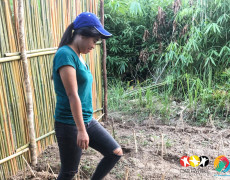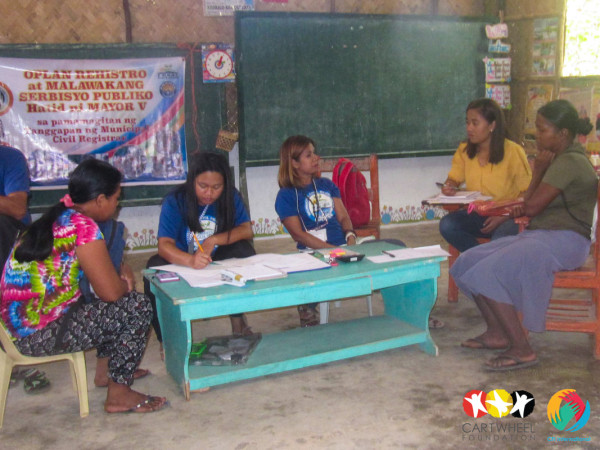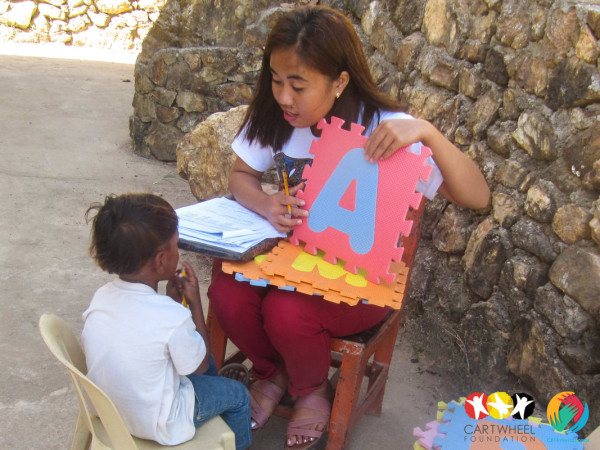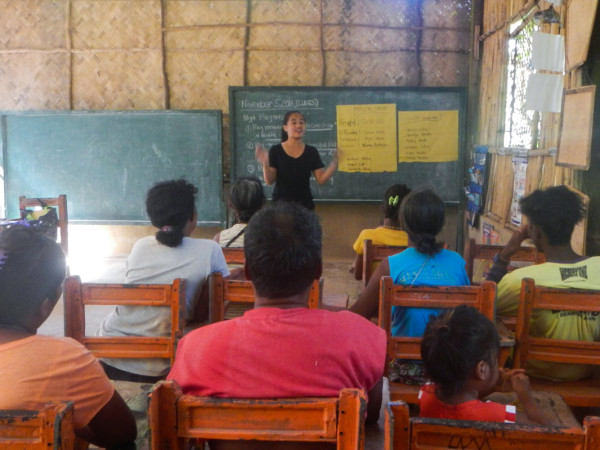Reasons for Hope: Reflections from an IP Volunteer

Chrislyn “Kring” Da-aw hails from the Dibabawon-Mangguangan tribe of New Corella, Davao del Norte. She is among eight Young Indigenous Peoples (YIP) Leaders Program grantees of Cartwheel Foundation Philippines (Cartwheel PH) who graduated in June 2018, completing their degree in Agricultural Technology from the University of Southeastern Philippines – Pamulaan Center for Indigenous Peoples Education.
With a genuine desire to reach out to others in service, Kring applied as a volunteer under the Companions of Assisi Development Foundation for Peace (CAP). Between 2018-2019, she was assigned as Project Development Associate of Cartwheel PH, working closely with the Tagbanua of Culion, Palawan.
Among her tasks was to help in the tedious groundwork necessary for completion of Tagbanua families’ civil registration processes, an initiative led by Cartwheel Foundation International (Cartwheel INTL) in collaboration with Cartwheel PH.
Here, she reflects on her year of service — gratefully celebrating small victories and humbly recognizing the remaining work towards community development that has yet to be done.
Why did you sign up as volunteer after graduating?
“I wanted to explore and understand the realities of other communities, to know about the experience of other IP groups.”
(“Gusto kong i-explore at alamin pa ang reyalidad ng ibang community, ang experience ng ibang katutubo.”)
What are some things you did as part of your work?
“I thought I would teach children and facilitate meetings. But to help with their civil registration, I initiated house-to-house visits to review their documents one at a time.
“This helped a lot, as we were able to determine concrete next steps in their registration process. They were also able to better understand said process and the other requirements needed for completion.
“There were other Tagbanua who took initiative and went straight to the municipal office. Still, there were other mothers and fathers who could not find time to follow through.”
(“Kala ko magtuturo ako ng bata at may mga meeting. Pero para makatulong sa civil registration, naisipan kong magbahay-bahay at tingnan ang kanilang mga papeles.
“Nakatulong ito at doon namin na-locate ang steps kung ano ang dapat gawin. Mas naintindihan nila yung proseso at mga requirements na dapat dalhin sa pag-register.
“May mga Tagbanua na nagkusa nang pumunta ng munisipyo. Pero mayroon ring mga nanay at tatay na hindi nila mabigyan ng oras.”)
From your understanding, why is acquiring a birth certificate important?
“A birth certificate has many uses. Without it, it may be hard to determine one’s identity and may not be recognized as part of a certain community.
“With a birth certificate, we are able to determine who is the eldest, who are among the same clan. It is also used for accessing services in education and health.”
(“Maraming pinaggagamitan ang birth certificate. Kung wala ito, mahirap ang pagkakakilala sa iyo at hindi ka recognized na taga-dyan sa community mo.
“Nang dahil sa birth certificate, nakikilala ang pinakamatanda, ang magkakamag-anak. Nagagamit rin ito sa mga serbisyong kaugnay ng edukasyon at kalusugan.”)

Together with the Municipal Civil Registrar, Kring (in yellow) assists Tagbanua with the registration process and their requirements
What are some of the things you learned during your volunteer year?
“On the civil registration process, I saw that it may be challenging at times because of the many processes involved. Much patience is needed with each of the community members.
“I learned patience from others who were with me in Culion. I saw that there is often need for self-control, for choosing words wisely.
“I recognized also that it is difficult to be away from my family, but it was a good way for me to know myself more. There were things I would not usually do back home but I was able to do while with the Tagbanua — because there was need for me to be in solidarity with them, to communicate often with many who were much older than me.”
(“Patungkol sa civil registration, mahirap gawin dahil maraming proseso. Kailangan ng pasensya sa tao mismo sa community.
“Natutunan ko rin ang pagpapasensya mula sa mga kasamahan ko sa Culion. Kailangan mo ring i-control ang sarili mo at maging maingat sa sasabihin sa kapwa mo.
“Mahirap malayo sa pamilya pero doon ko nakilala ang sarili ko. May mga bagay na hindi ko ginagawa pero nagagawa ko sa community; kinailangan kong makibagay at makipag-usap sa mga matatanda kahit mas bata ako.”)

Kring (leftmost) together with officers of Magsaragpun Tagbanua during their planning and evaluation session
What would you recommend for the Tagbanua community in moving forward?
“It would be best for the Tagbanua parents to continue training to better organize themselves. Magsaragpun Tagbanua, the existing parents’ organization, is a good place to start. Those who are already involved can influence others to do the same. It would be good to establish a better home-school connection through the parents.”
(“Mabuti kung patuloy ang training ng mga magulang para ma-organize sila. Magandang simula ang Magsaragpun Tagbanua, ang kanilang samahan sa kasalukuyan. Ang mga kasapi doon ang siyang maaaring mag-share sa iba. Mabuti kung may koneksyon ang bahay at ang paaralan.”)
Even as much work has yet to be done, what are reasons to hope for and in the Tagbanua?
“The Tagbanua children are very open and friendly. There are no longer afraid to interact with others and they enjoy sharing their own stories.
“Tagbanua mothers were at first simple attendees during meetings; they would just gather in one side and listen. But now, they raise their hands and share their opinions much more often.
“What’s beautiful about this is that you get to know them more through their stories. Their stories tell of their everyday concerns. You get to know their desires and their own hopes for themselves.”
(“Ang mga batang Tagbanua ay makwento at friendly. Hindi na sila takot makipag-usap at masaya silang makipagkwentuhan.
“Dati ang mga nanay ay nakaupo lang sa gilid sa tuwing may meeting. Ngayon sila ay nagtataas na ng kamay at nagsasabi ng kanilang opinyon nang mas madalas.
“Ang kagandahan doon ay makikilala mo sila base sa kwento nila. Bawat kwento nila ay may concern. At doon mo malalaman ang kanilang hangarin at pinapangarap para sa kanilang sarili.”)
As IPs reach out to fellow IPs, encouragement and hope abound– they make their voices heard and make their actions count, determined to create better change for themselves and their greater community.
This article also appears on the website of Cartwheel Foundation International.



